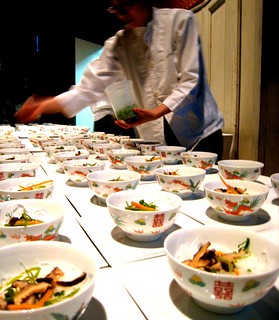Recipe: Happy Lunar New Year: Gong Xi Fa Choi!
Irene Khin Wong
 |
| Double Happiness Bowls |
Growing up in Myanmar, we celebrated Chú Xī, commonly known as Lunar New Year. Along with my parents, brother and sister, I would go to the night market and shop for the New Years decorations and sweets. My parents bought new outfits for all of us, and I would help my mom to stuff the red envelopes to give away, while she prepared feasts for the start of the New Year.
This year, I thought I'd ask my friend Grace Young, author of Stir-Frying to the Sky's Edge (the James Beard’s award winning author) what she and her family cook for the New Year.
According to her:
The New Year’s Eve dinner is the most important meal of the two week New Year’s celebration and of the entire year. Today many people choose to go to a restaurant because it’s more convenient but my family always gathered for dinner at home. Every family’s meal is slightly different while still being designed around meaning-laden foods.
Traditionally, eight or nine course are served because both are lucky numbers; eight sounds like the word for prosperity in Cantonese and nine means long-lasting. Some of our favorite dishes are a poached chicken which symbolizes the wholeness of life; stir-fried clams which have a shape similar to ancient Chinese coins and represents wealth; roast pig signifies purification; a stir-fry of lettuce which represents good fortune and prosperity; and a sweet and sour pork because the Cantonese word for sour sounds like the word for grandchild.
In old China, after the New Year’s eve meal, everyone would try and stay up as late as possible to safe guard the new Year. Adults would play mahjong late into the night or take an evening stroll anticipating the New Day. Firecrackers were traditionally set off at the end of the old year and at the beginning of the year to welcome the New Year and to frighten away evil spirits and demons. Wishing everyone a Happy Year of the Rabbit!
Recipe: Stir-Fried Clams with Black Bean Sauce
Ingredients:
2 dozen littleneck clams (about 2 pounds)
2 tablespoons Chinese dried fermented black beans
1/3 cup chicken broth
1 tablespoon Shao Hsing rice wine or dry sherry
1 teaspoon soy sauce
2 tablespoons peanut or vegetable oil
¼ cup chopped scallions
1 tablespoon minced garlic
1 tablespoon minced ginger
Instructions:
1. Thoroughly wash the clams in several changes of cold water, discarding any open clams. Scrub the shells with a stiff brush to remove grit and rinse well. Drain the clams in a colander shaking out excess water. Rinse the black beans in several changes of cold water and drain. In a small bowl, coarsely mash the beans with the back of a wooden spoon. In a small bowl, combine the broth, rice wine, and soy sauce.
2. Heat a 14-inch flat-bottomed wok or skillet over high heat until a bead of water vaporizes within 1 to 2 seconds of contact. Swirl in the oil, add the scallions, garlic, and ginger, and stir-fry 10 seconds or until the aromatics are fragrant. Add the clams, mashed beans, and stir-fry 1 minute.
Swirl the broth mixture into the wok, cover, and cook 3 minutes, stirring every minute.
Uncover, and stir-fry 1 minute or until the shells are fully open. Transfer any opened clams to a platter and continue stir-frying uncovered, over high heat about 1 minute or until all the shells have opened and the broth is reduced to a saucy consistency. Discard any unopened clams. Pour the sauce over the clams.
Serves 2 as a main dish with rice or 4 as part of a multicourse meal.